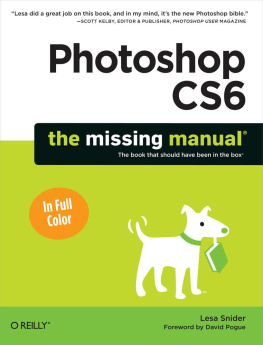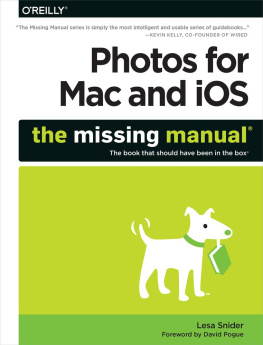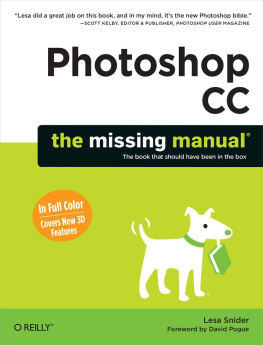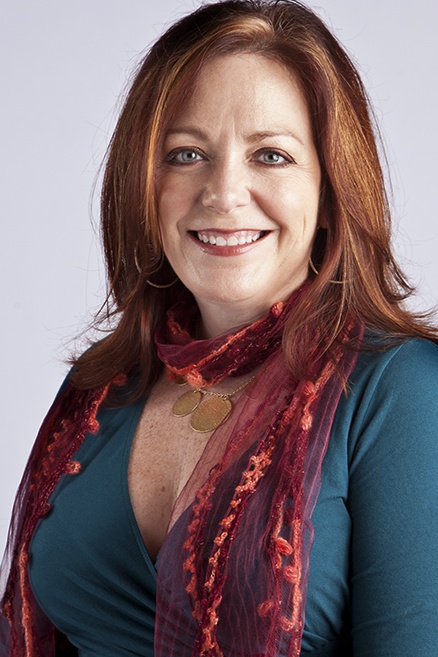Supplemental files and examples for this book can be found at http://examples.oreilly.com/0636920022718/. Please use a standard desktop web browser to access these files, as they may not be accessible from all ereader devices.
All code files or examples referenced in the book will be available online. For physical books that ship with an accompanying disc, whenever possible, weve posted all CD/DVD content. Note that while we provide as much of the media content as we are able via free download, we are sometimes limited by licensing restrictions. Please direct any questions or concerns to .
Foreword
In the short but crowded history of consumer technology, only two products ever became so common, influential, and powerful that their names became verbs .
Google is one.
Photoshop is the other.
(Did you Google that guy who asked you out? Yeahhes crazy. He Photoshopped his last girlfriend out of all his pictures!)
Its safe to say that these days, not a single photograph gets published, in print or online, without having been processed in Photoshop first. Its usually perfectly innocent stuff: a little color adjustment, contrast boosting, or cropping.
But not always. Sometimes, the editing actually changes the photo so that it no longer represents the original, and all kinds of ethical questions arise. Remember when TV Guide Photoshopped Oprahs head onto Ann-Margaret body? When Time magazine darkened O.J. Simpsons skin to make him look more menacing on the cover? Or when National Geographic moved two pyramids closer together to improve the composition?
Well, you get the point: Photoshop is magic. Thanks to Photoshop, photography is no longer a reliable record of reality.
And now, all that magic is in your hands. Use it wisely.
Trouble is, Photoshop is a monster . Its huge . Just opening it is like watching a slumbering beast heave into consciousness. Dudes: Photoshop has over 500 menu commands .
In short, installing Photoshop is like being told that youve just won a 747 jumbo jet. You sit down in the cockpit and survey the endless panels of controls and switches. Now what?
You dont even get a printed manual anymore.
If there were ever a piece of software that needed the Missing Manual treatment, it was Photoshop. And yet, despite having published over 100 books since I started this series in 1999, we had never tackled Photoshop. It was the elephant in the room for all those years, and it had been bugging me.
Frankly, we were terrified.
But no longer. In 2009, the beast was tamed at last by its new master, Lesa Snider: a natural-born Missing Manual author with Photoshop credentials as long as your arm.
She had worked on Missing Manuals, side by side with me in my office, for four years, in all kinds of editorial and production capacities. And when she wasnt at my place, she was out in the real world, teaching Photoshop seminars, writing Photoshop howto articles for the Web, retouching hundreds of photos in Photoshop, and eventually becoming a Photoshop master (which I would define as anyone who knows what more than 50 percent of those 500 menu commands actually do).
The result of all that training was that the Missing Manual mantra ran through her blood: Make it clear, make it entertaining, make it complete (hence the thickness of the book in your hands). And above all, dont just identify a feature: Tell us what its for . Tell us when to use it. (And if the answer is, Youll never use it, tell us that, too.)
The resulting Missing Manual about Photoshop was a critical and popular hit. Two editions later, Lesa is back, thank heaven, with a new edition to demystify Photoshop CS6.
Now, Ill be the first to admit that this book isnt for everybody. In fact, its aimed primarily at two kinds of people: Photoshop beginners and Photoshop veterans.
But seriously, folks. If youre new to Photoshop, youll find patient, friendly introductions to all those nutty Photoshoppy concepts like layers, color spaces, image resolution, and so on. And, mercifully, youll find a lot of loving attention to a time-honored Missing Manual specialtytips and shortcuts. As Photoshop pros can tell you, you pretty much have to learn some of Photoshops shortcuts, or it will crush you like a bug.
On the other hand, if you already have some Photoshop experience, youll appreciate this books coverage of CS6s new features. Some of them are pretty sweet indeed. (Content-Aware Move, tilt-shift blurring, text styles, video editingmmm.)
Heck, you might need this book just to find your way around Photoshops massively redesigned interface. Its quite a bit different. Its like coming home from college to discover that your parents redecorated your room without telling you.
In any case, get psyched. You now have both the most famous, powerful, magical piece of software on earthand an 800-page treasure map to help you find your way.
The only missing ingredients are time, some photos to work on, and a little good taste. Youll have to supply those yourself.
Good luck!
David Pogue
David Pogue is the weekly tech columnist for the New York Times, an Emmy-winning TV correspondent ( CBS News and NOVA on PBS), and the creator of the Missing Manual series .
The Missing Credits
About the Author
Lesa Snider is on a mission to teach the world to createand use!better graphics. Shes an internationally acclaimed speaker, a stock photographer, and the founder of the creative tutorial site .
During her free time, youll find Lesa carving the twisties on her sportbike, dressed up in her Star Trek best at a sci-fi convention, or hanging with fellow Apple Mac enthusiasts. Lesa is a proud member of the BMWMOA, F800 Riders Club, and the Colorado Mac User Group (.
About the Creative Team
Dawn Mann (editor) is associate editor for the Missing Manual series. When not working, she hikes, beads, and causes trouble. Email: .
Melanie Yarbrough (production editor) lives in Cambridge, Massachusetts, where she works as a production editor. When not ushering books through production, shes writing and baking whatever she can think up. Email: .
Julie Van Keuren (copy editor) quit her newspaper job in 2006 to move to Montana and live the freelancing dream. She and her husband, M.H. (who is living the novel-writing dream), have two sons, Dexter and Michael. Email: .














